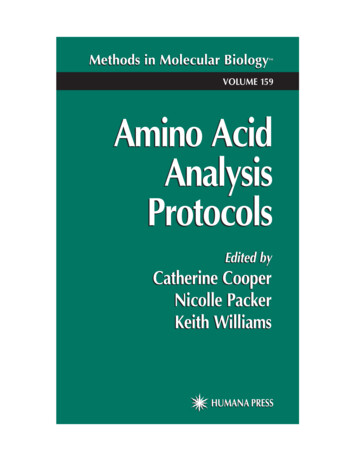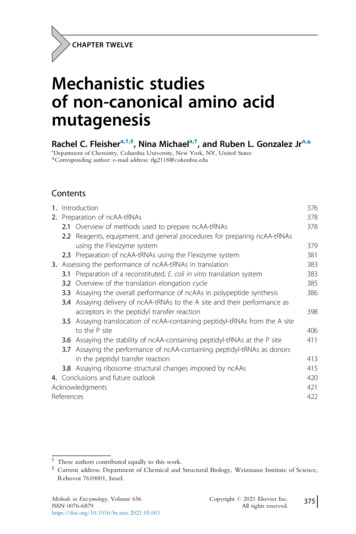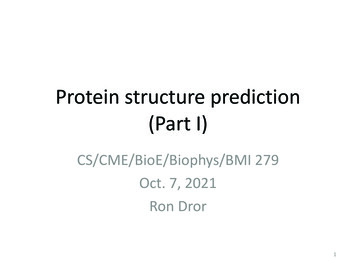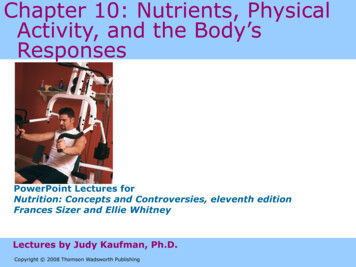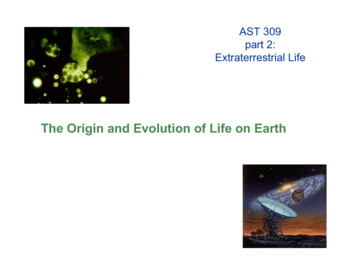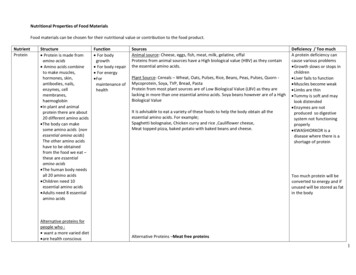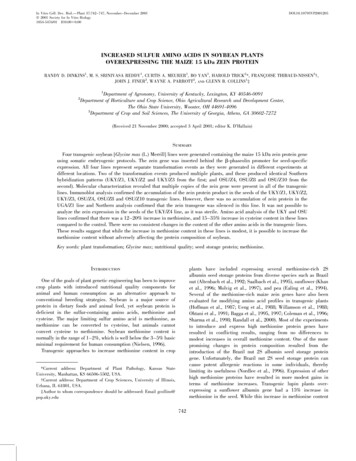
Transcription
In Vitro Cell. Dev. Biol.ÐPlant 37:742 747, November December 2001q 2001 Society for In Vitro Biology1054-5476/01 10.0010.00DOI:10.1079/IVP2001205INCREASED SULFUR AMINO ACIDS IN SOYBEAN PLANTSOVEREXPRESSING THE MAIZE 15 kDa ZEIN PROTEINRANDY D. DINKINS1, M. S. SRINIVASA REDDY1, CURTIS A. MEURER1, BO YAN1, HAROLD TRICK2*, FRANCËOISE THIBAUD-NISSEN3²,JOHN J. FINER2, WAYNE A. PARROTT3, and GLENN B. COLLINS1³21Department of Agronomy, University of Kentucky, Lexington, KY 40546-0091Department of Horticulture and Crop Science, Ohio Agricultural Research and Development Center,The Ohio State University, Wooster, OH 44691-40963Department of Crop and Soil Sciences, The University of Georgia, Athens, GA 30602-7272(Received 21 November 2000; accepted 3 April 2001; editor K. D'Halluin)SummaryFour transgenic soybean [Glycine max (L.) Merrill] lines were generated containing the maize 15 kDa zein protein geneusing somatic embryogenic protocols. The zein gene was inserted behind the b-phaseolin promoter for seed-specificexpression. All four lines represent separate transformation events as they were generated in different experiments atdifferent locations. Two of the transformation events produced multiple plants, and these produced identical Southernhybridization patterns (UKY/Z1, UKY/Z2 and UKY/Z3 from the first; and OSU/Z4, OSU/Z8 and OSU/Z10 from thesecond). Molecular characterization revealed that multiple copies of the zein gene were present in all of the transgeniclines. Immunoblot analysis confirmed the accumulation of the zein protein product in the seeds of the UKY/Z1, UKY/Z2,UKY/Z3, OSU/Z4, OSU/Z8 and OSU/Z10 transgenic lines. However, there was no accumulation of zein protein in theUGA/Z1 line and Northern analysis confirmed that the zein transgene was silenced in this line. It was not possible toanalyze the zein expression in the seeds of the UKY/Z4 line, as it was sterile. Amino acid analysis of the UKY and OSUlines confirmed that there was a 12 20% increase in methionine, and 15 35% increase in cysteine content in these linescompared to the control. There were no consistent changes in the content of the other amino acids in the transgenic lines.These results suggest that while the increase in methionine content in these lines is modest, it is possible to increase themethionine content without adversely affecting the protein composition of soybean.Key words: plant transformation; Glycine max; nutritional quality; seed storage protein; methionine.plants have included expressing several methionine-rich 2Salbumin seed storage proteins from diverse species such as Brazilnut (Altenbach et al., 1992; Saalbach et al., 1995), sunflower (Khanet al., 1996; Molvig et al., 1997), and pea (Ealing et al., 1994).Several of the methionine-rich maize zein genes have also beenevaluated for modifying amino acid profiles in transgenic plants(Hoffman et al., 1987; Ueng et al., 1988; Willamson et al., 1988;Ohtani et al., 1991; Bagga et al., 1995, 1997; Coleman et al., 1996;Sharma et al., 1998; Randall et al., 2000). Most of the experimentsto introduce and express high methionine protein genes haveresulted in conflicting results, ranging from no differences tomodest increases in overall methionine content. One of the morepromising changes in protein composition resulted from theintroduction of the Brazil nut 2S albumin seed storage proteingene. Unfortunately, the Brazil nut 2S seed storage protein cancause potent allergenic reactions in some individuals, therebylimiting its usefulness (Nordlee et al., 1996). Expression of otherhigh methionine proteins have resulted in more modest gains interms of methionine increases. Transgenic lupin plants overexpressing a sunflower albumin gene had a 15% increase inmethionine in the seed. While this increase in methionine contentIntroductionOne of the goals of plant genetic engineering has been to improvecrop plants with introduced nutritional quality components foranimal and human consumption as an alternative approach toconventional breeding strategies. Soybean is a major source ofprotein in dietary foods and animal feed, yet soybean protein isdeficient in the sulfur-containing amino acids, methionine andcysteine. The major limiting sulfur amino acid is methionine, asmethionine can be converted to cysteine, but animals cannotconvert cysteine to methionine. Soybean methionine content isnormally in the range of 1 2%, which is well below the 3 5% basicminimal requirement for human consumption (Nielsen, 1996).Transgenic approaches to increase methionine content in crop*Current address: Department of Plant Pathology, Kansas StateUniversity, Manhattan, KS 66506-5502, USA.²Current address: Department of Crop Sciences, University of Illinois,Urbana, IL 61801, USA.³Author to whom correspondence should be addressed: Email gcollins@pop.uky.edu742
SULFUR AMINO ACIDS IN SOYBEAN PLANTS743in lupin still falls short of the basic animal nutritional requirements,it is useful in a crop such as lupin, which is used primarily as feedfor sheep (Molvig et al., 1997).Animal-derived genes for high methionine proteins, such as thebovine b-casein protein (Maughan et al., 1999) and an avianovalbumin protein (Schroeder et al., 1991; Albert and Simuth,1993), can be introduced into plants resulting in higher methioninein the seed. However, it is doubtful that consumers will acceptanimal-derived proteins in plant products.The maize zein seed storage proteins are encoded by genefamilies that give rise to several species of proteins that are waterinsoluble and contain up to 37% methionine (Chui and Falco,1995). Efforts to overexpress the high methionine 10 and 22 kDamaize a-zein proteins in tobacco were unsuccessful as the zeinproteins failed to accumulate in the seed due to rapid degradation ofthe zein protein (Ohtani et al., 1991). In contrast, the 15 kDa zeinprotein is stable and accumulates in tobacco seed (Hoffman et al.,1987). Thus, the maize 15 kDa zein protein that contains 11%methionine is a good candidate for expression in species with lowseed methionine content. For this reason, we sought to express themaize gene for the 15 kDa zein protein in soybean as a candidate toincrease methionine content in the seed. In this report, we show thatexpression of the maize gene encoding the 15 kDa zein protein,driven by the seed-specific bean b-phaseolin promoter, results inan accumulation of the zein protein in the seeds and a significantincrease in methionine and cysteine content in soybean seed.Materials and MethodsGene constructs. The plasmid vectors used for transformation arepresented in Fig. 1. The zein gene-containing vector used for microprojectilebombardment (pBSPhZ) at The Ohio State University (OSU) locationcontained a BglII HindIII fragment consisting of the gene for the 15 kDazein protein, along with a portion of the zein 3 0 untranslated region and aNOS 3 0 terminator (Bagga et al., 1995), cloned into a BlueScript plasmidcontaining the bean b-phaseolin 2782 bp promoter (Burow et al., 1992).The pHygr plasmid (Finer et al., 1992) containing the hygromycinphosphotransferase gene was co-bombarded allowing hygromycin B to beused as the selective agent. At The University of Georgia (UGA) andUniversity of Kentucky (UKY) locations, an Agrobacterium binary plasmidvector was used for all transformations. Briefly, a SstI HindIII fragmentcontaining the b-phaseolin promoter, the 15 kDa zein protein encodinggene, a portion of the zein 3 0 untranslated region and the NOS 3 0 end fromthe pBSPhZ plasmid above was cloned into a modified pPZP100 vector(Hajdukyiewicz et al., 1994) containing the b-glucuronidase (Jefferson,1987) and hygromycin resistance genes (Gritz and Davies, 1983) to formpHIG/Zein (Fig. 1B). All molecular manipulations were carried out usingstandard procedures (Sambrook et al., 1989).Tissue culture and transformation. Soybean somatic embryogeniccultures, initiated and proliferated on solid medium containing 2,4dichlorophenoxyacetic acid (2,4-D) (Finer, 1988), as modified by methodsdescribed in Trick et al. (1997), were used at all three locations. The cultivar Jack' was used at the UKY and OSU locations, and the line F173',developed from a cross between Jack and PI 417138 and selectedspecifically for tissue culture (Bailey et al., 1993) was used at the UGAlocation. Agrobacterium-mediated transformation protocols, as described inYan et al. (2000), were used to introduce the transgene into soybean at theUKY location. Biolistic transformation, selection, and tissue cultureprotocols used at the three locations have been described in Trick et al.(1997) with modifications described in Samoylov et al. (1998a, b) for theGeorgia location.Southern analysis. Transgenic T1 (first sexual generation from primarytransgenic plants) zein plants used for Southern, immunoblotting andamino acid analysis, along with appropriate controls, were grown in thegreenhouse at the UKY location. For Southern analysis, DNA was isolatedfrom young leaves as described in Yan et al. (2000). Ten mg of DNA fromFig. 1. The maize 15 kDa zein protein gene plasmid vectors. A,pBSPhZ: BglII HindIII fragment consisting of the gene for the 15 kDa zeinprotein, along with a portion of the zein 3 0 untranslated region and a NOS 3 0terminator (Bagga et al., 1995), cloned into a BlueScript plasmid containingthe bean b-phaseolin 2782 bp promoter (Burow et al., 1992). B, pHIG/Zein:SstI HindIII fragment of pBSPhZ containing the phaseolin-zein cassettecloned into a modified pPZP100 (Hajdukyiewicz et al., 1994) Agrobacteriumbinary plasmid vector containing the b-glucuronidase (Jefferson, 1987) andhygromycin resistance genes (Gritz and Davies, 1983).each plant were digested overnight with HindIII, separated on a 0.8%agarose gel and blotted onto Zetaprobe' membrane (BioRad Laboratories,Hercules, CA). Hybridization was done overnight at 428C in a formamidesolution with a 710-bp EcoRI/BglII maize 15 kDa zein gene fragmentrandom-primed with a32P dCTP using the Prime-Itq II Random PrimerLabeling Kit (Stratagene, La Jolla, CA). The membrane was washed threetimes at room temperature in 0:1 SSC and 0.1% SDS and exposed in aphosphorimager cassette (Molecular Dynamics, Inc., Sunnyvale, CA). Thebands were quantified using the ImageQuante software (MolecularDynamics, Inc.).Immunoblot analysis. Mature seeds of the different transgenic plantswere homogenized in 10 mM sodium phosphate buffer (pH 6.8) containing1 mM phenylmethylsulfonyl fluoride (PMSF). The homogenate was centrifuged at 12 000 g for 10 min and the supernatant was collected. Thepellet from centrifugation was incubated in 70% ethanol containing 1% 2mercaptoethanol at 658C for 30 min with occasional shaking. The samplewas then centrifuged at 12 000 g for 10 min and the supernatant wascollected again. The protein concentration was estimated by the BioRadprotein assay method (BioRad Laboratories). For immunoblot analysis, 5 mgof phosphate buffer soluble or ethanol soluble protein was subjected to asodium dodecyl sulfate-polyacrylamide gel electrophoresis (SDS-PAGE)(Laemmli, 1970) using a 14% acrylamide gel. Fractionated proteins were
744DINKINS ET AL.electroblotted onto a nitrocellulose membrane in 25 mM Tris, 192 mMglycine, and 5% methanol (pH 8.2). The membrane was blocked for 2 h in5% dry milk powder in Tris-buffered saline containing 0.05% Tween 20and then incubated in the same solution with the glycinin antisera (giftfrom Dr. Lila Vodkin, University of Illinois, Urbana, IL) or 15 kDa zeinantisera (Bagga et al., 1995). Antigen antibody complexes were visualizedusing horseradish peroxidase (HRP)-conjugated goat anti-rabbit IgG andan enhanced chemiluminescence kit (Amersham Pharmacia Biotech,Buckinghamshire, UK).Amino acid analysis. A seed sample consisting of 25 mature dry seedsfrom each line was crushed to provide a 2 g sample that was sent to theMolecular Structure Facility (University of California-Davis) for analysis.Detection and analysis of amino acids were performed in accordance withpublished protocols (Cooper et al., 2000). Formic and performic acidhydrolysis reactions were conducted on sub-samples of each line (Hirs,1967). Eluted fractions from samples were analyzed on a Beckman 6300amino acid analyzer utilizing a sodium citrate buffer system. Amino acidswere separated using ion-exchange chromatography. Sulfur-containingamino acids were extracted as methionine sulfone and cysteic acid via theperformic acid protocol. These values were then normalized to the data forthe remaining amino acids, which were extracted via the formic acidprotocol, by calculating their presence relative to leucine and arginineextracted via perfomic acid.Results and DiscussionA total of eight transgenic soybean plants derived from fourindependent transformation experiments containing the maize15 kDa zein gene were regenerated at the UKY (UKY/Z1, UKY/Z2, UKY/Z3 and UKY/Z4), OSU (OSU/Z4, OSU/Z8 and OSU/Z10)and UGA (UGA/Z1) locations. Three of the UKY plants (UKY/Z1,UKY/Z2 and UKY/Z3) were transformed lines via the A.tumefaciens-mediated transformation system, and we have previously shown that these originated from a single initialtransformation event (Yan et al., 2000). Since the three plantsrepresent the same transformation event, further analysis was doneon the UKY/Z1 plant and progeny only. The fourth, UKY/Z4, wasobtained by particle bombardment and from a separate experiment.The three OSU plants were obtained by particle bombardment fromone experiment. A Southern blot was done to confirm the presenceof the zein gene in the genome and to compare lines derived fromthe three locations (Fig. 2). The restriction enzyme HindIII, used todigest total DNA, excises a band of 4.5 kb from the pHIG/Zein TDNA. A single band of the correct size is found in the UKY/Z1plant (Fig. 2). Similarly, a primary 4.5-kb band was observed in theUKY/Z4 line and the UGA/Z1 lines where the pHIG/Zein vectorwas used (Fig. 2). Additional bands were also observed in the twoparticle-gun derived lines, suggesting that rearranged, truncated orpartial DNAs also integrated into the genomic DNA. The restrictionenzyme HindIII cuts the DNA only once within the zein BlueScriptvector, thus the multiple bands observed in the OSU lines arerepresentative of the copy number. The three plants from OSU showthe same hybridization pattern on the Southern blot indicating thatthe three plants are derived from the same initial transformationevent.We have previously determined that the UKY/Z1 line containsthree copies of the T-DNA in tandem (Yan et al., 2000), thus wecalculated the number of inserts in the other lines using thephosphorimager software ImageQuante (Molecular Dynamics,Inc.). The UKY/Z4 line, derived by particle bombardment usingthe pHIG/Zein vector, shows three bands on the Southern blot, twocopies at expected 4.5 kb size, two copies of a larger (,8 kb)rearranged T-DNA and a smaller partial or truncated fragmentFig. 2. Southern blot of transgenic soybean plants containing the maize15 kDa zein protein gene. Lanes: (1) pHIG/Z, the pHIG/Zein plasmid cutwith HindIII; (2) UKY/Z4; (3) UKY/Z1; (4) WT, non-transgenic Jack soybeancultivar; (5) OSU/Z4; (6) OSU/Z8; (7) OSU/Z10; (8) UGA/Z1. Tenmicrograms of transgenic soybean genomic DNA was cut with therestriction enzyme HindIII and hybridized with an EcoRI/BglII fragmentof the pBSPhZ plasmid containing the entire maize 15 kDa zein proteinencoding region.Fig. 3. Immunoblot hybridization of zein transgenic soybean plants. A,15 kDa zein specific antibody (gift from S. Bagga, New Mexico StateUniversity); B, soybean 12 S glycinin seed storage protein polyclonalantibody (gift from L. Vodkin, University of Illinois).
745SULFUR AMINO ACIDS IN SOYBEAN PLANTS(3 kb) containing the zein gene (Fig. 2). Molecular analysis has notbeen conducted to determine the structure of the inserts. Theestimated number of copies in the UGA/Z1 line is between 100 and110, with approximately 70 that still contain both HindIII sites inthe inserted T-DNA to produce the 4.5 kb band. In addition, severalbands, larger and smaller than 4.5 kb, were also observed in theUGA/Z1 line suggesting that truncation and/or re-arrangement ofthe bombarded T-DNA occurred in some of the inserted DNAs.The number of copies calculated for the OSU lines is between 77and 85. The single intense hybridization band at 4.7 kb indicatesthe formation of multiple tandem repeats of at least 12 plasmidcopies. Insertions of multiple plasmids with some degree ofconcatenation are possible during microprojectile bombardment ofsoybean (Hadi et al., 1996). The high probability of co-transformation of multiple plasmids has been the background for cobombardment of a plasmid containing the gene for selection alongwith a plasmid containing the gene of interest. Thus, it should beeasier to segregate the plasmid containing the gene used forselection from the gene of interest in the genome by hybridization.However, introduction of high copy numbers of the introduced genemay result in gene silencing (Matzke et al., 1994).Zein protein accumulation. In order to determine the accumulation of the zein protein in the seeds, an immunoblot wasperformed using protein samples isolated from mature seeds (Fig. 3).The results showed that zein protein accumulated in the UKY/Z1and OSU/Z8 seeds, but not in the UGA/Z1. Analysis of the zeinprotein levels in seeds of UKY/Z4 line was not done, as this plantwas not fertile. Immunoblots of the same seed protein samplesshowed that there were no differences in accumulation of the 11 Sglycinin seed storage protein in the seed (Fig. 3B).Zein protein accumulation correlates well with our results of zeinmRNA accumulation in the seeds of the UKY and OSU lines (datanot shown). Zein protein and mRNA were not detected in the UGAline suggesting that the zein transgenes were silenced in this line.Multiple inserts have a propensity to result in gene silencing due tohypermethylation (Matzke et al., 1994). Variation was also observedin the level of accumulation of the zein protein in the OSU plants(data not shown). Since these plants were all derived from a singletransformation event, it is possible that gene silencing is stilloccurring due to the high copy number of the inserted DNA in thetransformed line. Further analysis will be required to determine theextent of zein protein accumulation in future generations of theseplants.Seed amino acid analysis. Total amino acid profiles wereperformed on T2 seeds derived from individual OSU and UKY linesthat showed positive expression for the zein protein by immunoblot(Table 1). All of the transgenic lines had changes in methioninecontent greater than 10% compared to the wild-type cultivar Jack.None of the other amino acids showed any consistent differencesgreater than 10% compared to the control (Table 1). On average,there was a 12 20% and 15 35%, respectively, increase in themethionine and cysteine content of the transgenic-derived linescompared to the control. Since only seed from plants grown undergreenhouse conditions were examined, it is not possible todetermine the overall environmental variability. However, seedsfrom the four UKY/Z1 T2 lines showed a similar increase inmethionine and cysteine content and only minor differences in theother amino acids suggesting that the observed increase isheritable.Although the increase in methionine and cysteine content in thetransgenic soybean appears to be consistent in the transgenic linesexamined, the change in the sulfur amino acid content in thetransgenic plants described herein falls short of the needed increaseto represent a sufficient source of methionine and cysteine in thediet (Tabe and Higgins, 1998). For this to be accomplished, themethionine content must, at least, be doubled in soybean seeds. It ispossible that a higher accumulation of methionine can be found asmore transgenic plants are examined. Although four original zeinlines were generated, the results on zein accumulation in the seedspresented herein are based on two independent transformationevents. Thus additional transgenic lines will be needed to fullydetermine the potential of this construct in changing the methioninecontent in soybean seeds.It is possible that methionine and cysteine are in limiting supplyduring soybean seed development. This scenario is unlikelybecause changes in the methionine content of soybean seed havebeen shown using the Brazil nut albumin gene (Townsend andThomas, 1994). Nitrogen application tends to result in a decrease inmethionine content, as there is an increase in the b subunit ofconglycinin, a subunit of the 7 S seed storage protein that isextremely poor in methionine (Pack et al., 1997). However, whiledirect application of methionine to whole plants during seed setTABLE 1TOTAL WEIGHT PERCENTAGE OF AMINO ACIDS IN SOYBEAN ZEIN TRANSGENIC HISLYSARGCYSTMETJack 5UKY/Z1-1215 kDa zein notypes are as follows: Jack Control, field-grown plants harvested in 1997; OSU/Z4 and OSU/Z10, seeds derived from individual T1 plants originating fromOSU/Z4 and OSU/Z10; UKY/Z1-29, UKY/Z1-25, UKY/Z1-15 and UKY/Z1-12, seeds from T1 plants derived from UKY/Z1 transgenic plant; 15 kDa zein protein,percent of each amino acid in the 15 kDa maize zein polypeptide.Changes greater than 10% of the wild-type are presented in bold.
746DINKINS ET AL.does increase the seed storage methionine content somewhat(Grabau et al., 1986), application of methionine to developingcotyledons (Holowach et al., 1984) results in no significant changesin methionine content in the seed storage proteins. These resultssuggest that methionine is not limiting, but that expression of themethionine-poor seed storage proteins is the major factorresponsible for the low level observed. Thus, a major objective toincrease the methionine content in developing soybean seed, wouldbe to express seed storage protein genes where the protein wouldaccumulate stably in the seed. It is possible that the bean bphaseolin promoter is not a sufficiently strong' promoter comparedwith other soybean seed storage protein gene promoters in thedeveloping soybean seed. The b-phaseolin promoter was used toachieve expression in the seed. However, if the observed increase inmethionine content turns out to be the maximum possible with theb-phaseolin promoter, it may be necessary to use other seedspecific promoters or enhancer elements to achieve a nutritionallysignificant increase in methionine in the seed.In conclusion, our results, along with previous results using theBrazil nut albumin and sunflower albumin, suggest that increase inoverall methionine content in the seed is feasible for soybean usinga transgenic approach. The methionine and cysteine levels observedin the present study, while greater than the wild-type control, couldprobably be further improved with changes in promoter and/or seedstorage protein vector construction design.AcknowledgmentsThe authors wish to thank Carl Redmond, Kay McAllister, Michael Hayes,Donna Tucker, Julie Essig, Holly Frantz, Ray Stevens, and Leroy Duncan forvaluable technical support. This research was supported by the UnitedSoybean Board, and the Agricultural Experiment Stations in Georgia,Kentucky, and Ohio. This paper (00-06-161) is published with the approvalof the Director of the Kentucky Agricultural Experiment Station.ReferencesAlbert, S.; Simuth, J. Construction of modified cloning system forexpression of Japanese quail ovalbumin in transgenic plants.BioloÂgia 48:689 692; 1993.Altenbach, S. B.; Kuo, C. C.; Staraci, L. C.; Pearson, K. W.; Wainwright, C.;Georgescu, A.; Townsend, J. Accumulation of a Brazil nut albumin inseeds of transgenic canola results in enhanced levels of seed proteinmethionine. Plant Mol. Biol. 18:235 245; 1992.Bagga, S.; Adams, H.; Kemp, J. D.; Sengupta-Gopalan, C. Accumulation of15-kilodalton zein in novel protein bodies in transgenic tobacco.Plant Physiol. 107:13 23; 1995.Bagga, S.; Adams, H. P.; Rodriguez, F. D.; Kemp, J. D.; Sengupta-Gopalan,C. Coexpression of the maize delta-zein and beta-zein genes resultsin stable accumulation of delta-zein in endoplasmic reticulumderived protein bodies formed by beta-zein. Plant Cell 9:1683 1696;1997.Bailey, M. A.; Boerma, H. R.; Parrott, W. A. Genotype effects onproliferative embryogenesis and plant regeneration of soybean. InVitro Cell. Dev. Biol. Plant 29:102 108; 1993.Burow, M. D.; Sen, P.; Chlan, C. A.; Murai, N. Developmental control of theb-phaseolin gene requires positive, negative and temporal seedspecific transcriptional regulatory elements and a negative elementfor stem and root expression. Plant J. 2:537 548; 1992.Chui, C.-F.; Falco, S. C. A new methionine-rich seed storage protein frommaize. Plant Physiol. 107:291; 1995.Coleman, C. E.; Herman, E. B.; Takasaki, K.; Larkins, B. A. The maize gzein sequesters a-zein and stabilizes its accumulation in proteinbodies of transgenic tobacco endosperm. Plant Cell 8:2335 2345;1996.Cooper, C.; Packer, N.; Williams, K. Amino acid analysis protocols. In:Methods in molecular biology, vol. 159. Totawa, NJ: Humana Press;2000:9 30.Ealing, P. M.; Hancock, K. R.; White, D. W. R. Expression of the peaalbumin 1 gene in transgenic white clover and tobacco. TransgenicRes. 3:344 354; 1994.Finer, J. J. Apical proliferation of embryogenic tissue of soybeans [Glycinemax (L.) Merrill]. Plant Cell Rep. 7:238 241; 1988.Finer, J. J.; Vain, P.; Jones, M. W.; McMullen, M. D. Development of theparticle inflow gun for DNA delivery to plant cells. Plant Cell Rep.11:232 238; 1992.Grabau, L.; Blevins, D. L.; Minor, H. C. Stem infusions enhance methioninecontent of soybean storage protein. Plant Physiol. 82:1013 1018;1986.Gritz, L.; Davies, J. Plasmid-encoded hygromycin B resistance: the sequenceof hygromycin B phosphotransferase gene and its expression inEscherichia coli and Saccharomyces cerevisiae. Gene 25:179 188;1983.Hadi, M. Z.; McMullen, M. D.; Finer, J. J. Transformation of 12 differentplasmids into soybean via particle bombardment. Plant Cell Rep.15:500 505; 1996.Hajdukyiewicz, P.; Svab, Z.; Maliga, P. The small, versatile pPZP family ofAgrobacterium binary vectors for plant transformation. Plant Mol.Biol. 25:989 994; 1994.Hirs, C. H. W. Determination of cystine as cysteic acid. In: Hirs, C. H. W.,ed. Methods in enzymology, vol. 11. New York: Academic Press;1967:59 62.Hoffman, L. M.; Donaldson, D. D.; Bookland, R.; Rashka, K.; Herman, E. M.Synthesis and protein body deposition of maize 15-kD zein intobacco seeds. EMBO J. 6:3213 3221; 1987.Holowack, L. P.; Thompson, J. F.; Madison, J. T. Storage protein compositionof soybean cotyledons grown in vitro in media of various sulfateconcentrations in the presence and absence of exogenous lmethionine. Plant Physiol. 74:584 589; 1984.Jefferson, R. A. Assaying chimeric genes in plants: the GUS gene fusionsystem. Plant Mol. Biol. Rep. 5:387 405; 1987.Khan, M. R. I.; Ceriotti, A.; Tabe, L.; Aryan, A.; McNabb, W.; Moore, A.;Craig, S.; Spencer, D.; Higgins, T. J. V. Accumulation of a sulphurrich seed albumin from sunflower in the leaves of transgenicsubterranean clover (Trifolium subterraneum L.). Transgenic Res.5:179 185; 1996.Laemmli, U. K. Cleavage of structural proteins during the assembly of thehead of bacteriophage T4. Nature 227:680 685; 1970.Matzke, M.; Matzke, A. J. M.; Mittelsten-Scheid, O. Homology-dependentgene silencing in transgenic plants: epistatic silencing loci containmultiple copies of methylated transgenes. Mol. Gen. Genet.244:219 229; 1994.Maughan, P. J.; Philip, R.; Cho, M.-J.; Widholm, J. M.; Vodkin, L. O.Biolistic transformation, expression, and inheritance of bovine bcasein in soybean (Glycine max). In Vitro Cell. Dev. Biol. Plant35:334 349; 1999.Molvig, L.; Tabe, T. M.; Eggum, B. O.; Moore, A. E.; Craig, S.; Spencer, D.;Higgins, T. J. V. Enhanced methionine levels and increased nutritivevalue of seeds of transgenic lupins (Lupinus angustifolius L.)expressing a sunflower seed albumin gene. Proc. Natl Acad. Sci.USA 94:8393 8398; 1997.Nielsen, N. C. Soybean seed composition. In: Verma, D. P. S.; Shoemaker,R. D., eds. Soybean genetics, molecular biology and biotechnology.Wallingford, UK: CAB International; 1996:127 163.Nordlee, J. A.; Taylor, S. L.; Townsend, J. A.; Thomas, L. A.; Bush, R. K.Identification of a Brazil-nut allergen in transgenic soybeans. N.Engl. J. Med. 334:688 692; 1996.Ohtani, T.; Galili, G.; Wallace, J. C.; Thompson, G. A.; Larkins, B. A.Normal and lysine-containing zeins are unstable in transgenictobacco seeds. Plant Mol. Biol. 16:117 128; 1991.Pack, N. C.; Imsande, J.; Shoemaker, R. C.; Shibles, R. Nutritional control ofsoybean seed storage protein. Crop Sci. 37:498 503; 1997.
SULFUR AMINO ACIDS IN SOYBEAN PLANTSRandall, J.; Bagga, S.; Adams, H.; Kemp, J. D. A modified 10 kD zeinprotein produces two morphologically distinct protein bodies intransgenic tobacco. Plant Sci. 150:21 28; 2000.Saalbach, I.; Pickardt, T.; Waddell, D. R.; Hillmer, S.; Schieder, O.; Muntz,K. The sulphur-rich Brazil nut 2S albumin is specifically formed intransgenic seeds of the grain legume Vicia narbonensis. Euphytica85:181 192; 1995.Sambrook, T.; Fritsch, E. F.; Maniatis, T. Molecular cloning a laboratorymanual. Cold Spring Harbor, NY: Cold Spring Harbor LaboratoryPress; 1989.Samoylov, V. M.; Tucker, D. M.; Parrott, W. A. A liquid medium-b
Amino acid analysis. A seed sample consisting of 25 mature dry seeds from each line was crushed to provide a 2 g sample that was sent to the Molecular Structure Facility (University of California-Davis) for analysis. Detection and analysis of amino acids were performed in accordance with pu
